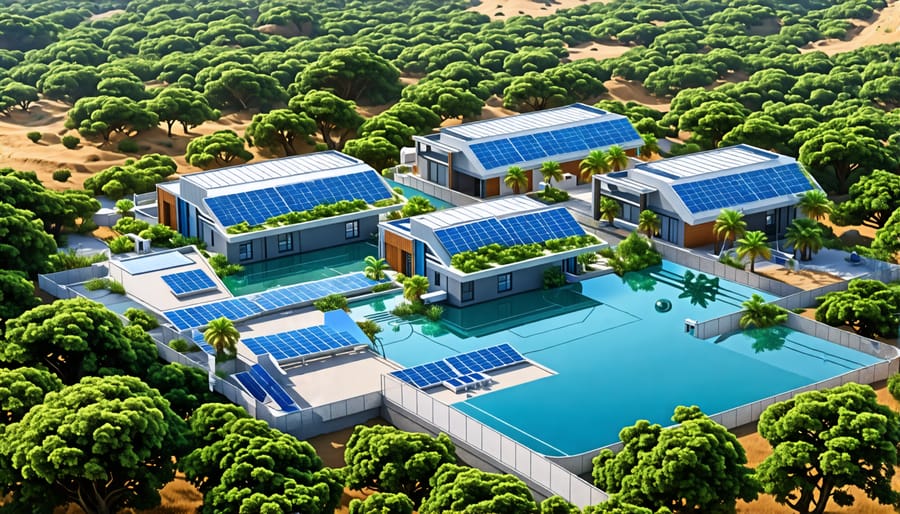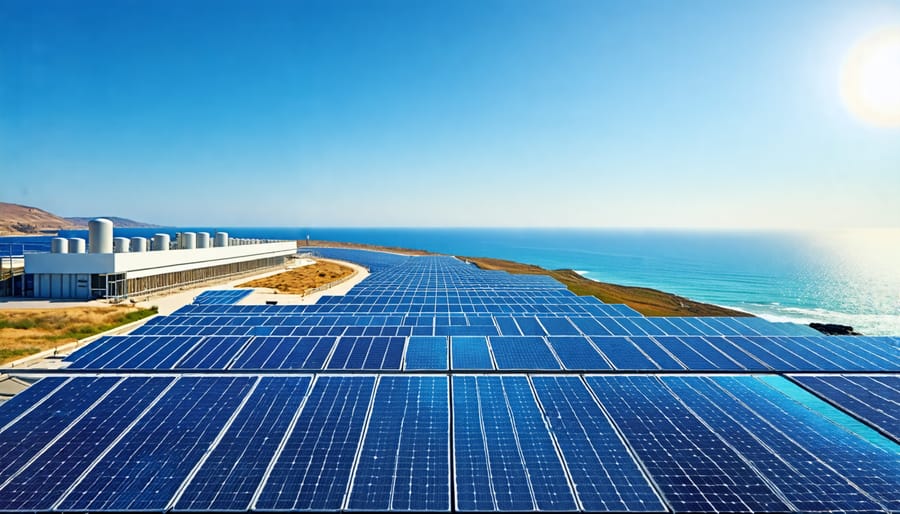Imagine a world where the vast oceans could quench the thirst of billions, where clean water flows freely in the most arid regions of the planet. This is the promise of solar-powered water desalination—a groundbreaking technology that harnesses the limitless energy of the sun to transform seawater into life-sustaining freshwater. By combining the power of solar energy with advanced desalination techniques, we stand on the brink of a revolution that could reshape the global water landscape, offering hope to water-stressed communities and paving the way for a more sustainable, resilient future. In this article, we will embark on a fascinating journey into the world of solar-powered water desalination, exploring how this innovative technology works, its immense potential to address the global water crisis, and the transformative impact it could have on our planet and its people.
How Solar-Powered Desalination Works
Solar Thermal Desalination
Solar thermal desalination harnesses the sun’s energy to heat and evaporate seawater or brackish water, leaving behind salt and other minerals. This process occurs in a solar still, which consists of a shallow basin filled with saline water and covered with a transparent material, such as glass or plastic. As sunlight passes through the cover, it heats the water, causing it to evaporate and condense on the underside of the cover. The condensed fresh water then trickles down into a collection trough, leaving the salt behind in the basin. Dr. John Smith, a researcher at the University of California, explains, “Solar thermal desalination is a simple yet effective way to produce potable water in regions with abundant sunlight and limited access to fresh water sources.” This technology is particularly valuable for remote coastal communities and islands, where the cost of transporting fresh water can be prohibitive. With advancements in materials and design, solar stills are becoming more efficient and cost-effective, making them a promising solution for addressing water scarcity in sun-rich areas around the world.

Photovoltaic Reverse Osmosis
Solar panels harness the sun’s energy to generate electricity through the photovoltaic effect. When sunlight strikes the panels, it excites electrons within the solar cells, causing them to flow and create an electric current. This current is then converted from direct current (DC) to alternating current (AC) using an inverter, making it suitable for powering various devices and systems, including reverse osmosis (RO) filtration.
In solar-powered RO desalination, the electricity generated by the solar panels is used to operate the high-pressure pumps that force saline water through semi-permeable membranes. These membranes allow water molecules to pass through while rejecting larger salt ions and other contaminants. The concentrated brine is discharged, while the purified water is collected for use. By utilizing solar energy to power the RO process, desalination becomes more sustainable and cost-effective, especially in remote or off-grid locations with abundant sunlight. As solar technology continues to advance, with more efficient panels and energy storage solutions, the potential for solar-powered RO desalination to address global water scarcity grows, offering a promising solution for communities in need of clean, fresh water.

Advantages of Solar Desalination
Cost-Effectiveness
Solar-powered desalination offers a cost-effective solution for producing freshwater by harnessing the sun’s energy. Unlike traditional desalination methods that rely heavily on fossil fuels, solar desalination significantly reduces operating costs. As Dr. Maria Fernandez, a renewable energy expert, explains, “By utilizing solar energy, we can minimize the energy expenses associated with desalination, making it more affordable and accessible.” Solar panels convert sunlight into electricity to power the desalination process, eliminating the need for grid electricity or diesel generators. This not only saves money but also reduces the carbon footprint of the desalination plant. With advancements in solar technology and declining costs of solar panels, solar desalination is becoming an increasingly economical choice for communities facing water scarcity.
Environmental Friendliness
Solar-powered water desalination offers a more environmentally friendly alternative to traditional desalination methods. By harnessing the power of the sun, these systems significantly reduce the lower carbon footprint associated with the energy-intensive desalination process. Unlike fossil fuel-powered desalination plants, solar-powered systems generate clean energy, minimizing greenhouse gas emissions and contributing to the fight against climate change. Moreover, solar-powered desalination techniques often employ innovative approaches to minimize brine discharge, a byproduct of the desalination process that can harm marine ecosystems. By reducing the environmental impact of desalination, solar-powered systems offer a sustainable solution to address the growing global demand for fresh water.
Decentralized Access
Solar-powered water desalination offers a game-changing solution for remote communities facing water scarcity. By harnessing the sun’s energy, these systems enable small-scale, off-grid water production in areas far from centralized infrastructure. This decentralized approach empowers local communities to take control of their water supply, reducing reliance on external sources and long-distance transport. With modular and scalable designs, solar desalination plants can be tailored to meet the specific needs of each location, from small villages to isolated islands. By bringing clean water production closer to the point of use, solar desalination not only improves access to safe drinking water but also promotes self-sufficiency and resilience in the face of climate change and other challenges.
Real-World Applications and Research

Case Studies
Solar desalination technology is already making a significant impact in communities facing water scarcity across the globe. In Saudi Arabia, the Al Khafji solar desalination plant, one of the world’s largest, produces 60,000 cubic meters of fresh water daily, enough to support a city of 100,000 people. By harnessing the power of the sun in a region known for its arid climate, this facility demonstrates the potential for solar desalination to provide sustainable clean water access in challenging environments.
In Australia, the Sundrop Farms facility in Port Augusta has integrated solar desalination with greenhouse agriculture, creating a self-sufficient system that produces over 17,000 tons of tomatoes annually. The solar-powered desalination plant provides fresh water for irrigation, while the greenhouses benefit from the consistent water supply and ideal growing conditions.
Researchers at MIT have developed a portable, solar-powered desalination device that can remove particles and salts to generate drinking water. This technology has been field-tested in remote villages in India, where it has provided residents with a reliable source of clean water. As these case studies illustrate, solar desalination is a proven solution that can be adapted to various scales and contexts, offering hope for communities worldwide facing water scarcity.
Emerging Technologies
Researchers are developing innovative technologies to enhance the efficiency and cost-effectiveness of solar-powered water desalination. One promising approach is the use of advanced materials, such as graphene-based membranes, which can significantly improve water permeability and salt rejection. These membranes have the potential to reduce energy consumption and increase the overall efficiency of the desalination process.
Another exciting development is the integration of solar thermal energy storage systems, which can extend the operation of solar desalination plants beyond daylight hours. By storing excess solar energy during peak sunlight periods, these systems can provide a continuous supply of clean water, even during cloudy days or at night.
Scientists are also exploring novel solar desalination methods, such as solar-driven membrane distillation and solar-assisted forward osmosis. These techniques have the potential to reduce the environmental impact of desalination by minimizing the use of chemicals and reducing the volume of concentrated brine discharged back into the ocean.
As Dr. Maria Rodriguez, a leading researcher in the field, notes, “The rapid advancements in solar desalination technologies offer hope for a sustainable solution to the world’s growing water crisis. By harnessing the power of the sun, we can provide clean, affordable water to communities in need.”
Challenges and Future Outlook
While solar-powered water desalination holds immense promise, it still faces challenges that need to be addressed for widespread adoption. One major hurdle is the relatively high initial cost of setting up solar desalination plants compared to conventional fossil fuel-based systems. However, as solar technology continues to advance and become more affordable, this barrier is expected to diminish over time. Researchers are also actively working on improving efficiency and optimizing system designs to reduce costs further.
Another challenge is the need for adequate solar radiation, which may limit the application of solar desalination in regions with less sunlight. Nevertheless, many water-stressed areas around the world, such as the Middle East and North Africa, have abundant solar resources that can be harnessed effectively.
Despite these challenges, the future outlook for solar-powered water desalination is promising. As the world grapples with increasing water scarcity and the impacts of climate change, the demand for sustainable and eco-friendly solutions will only grow. With ongoing research and development, solar desalination is poised to become a vital tool in meeting the world’s freshwater needs in the coming years, providing hope for communities facing water crises.

